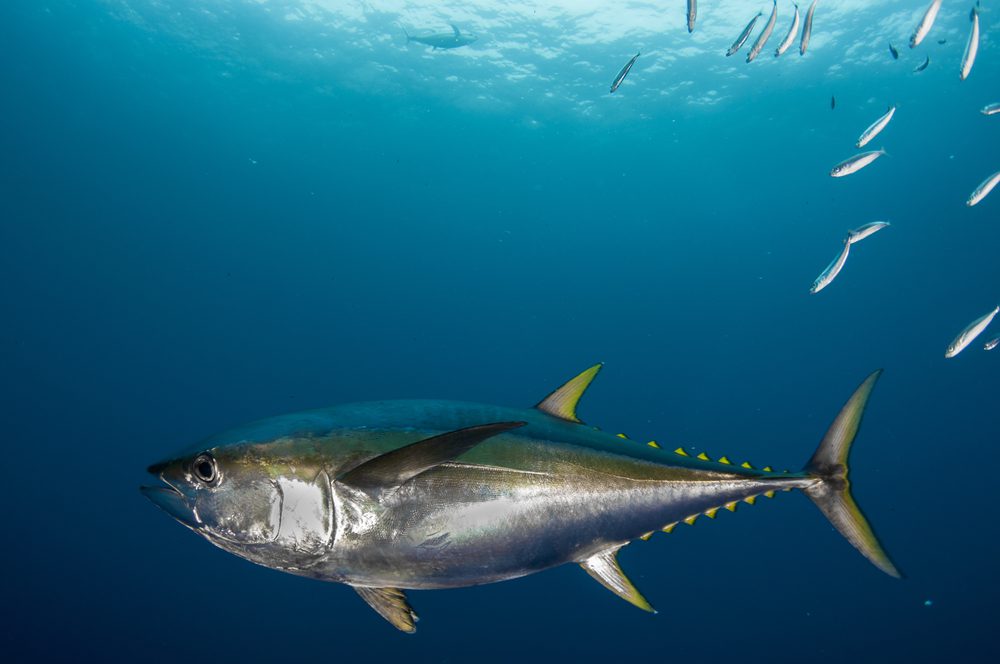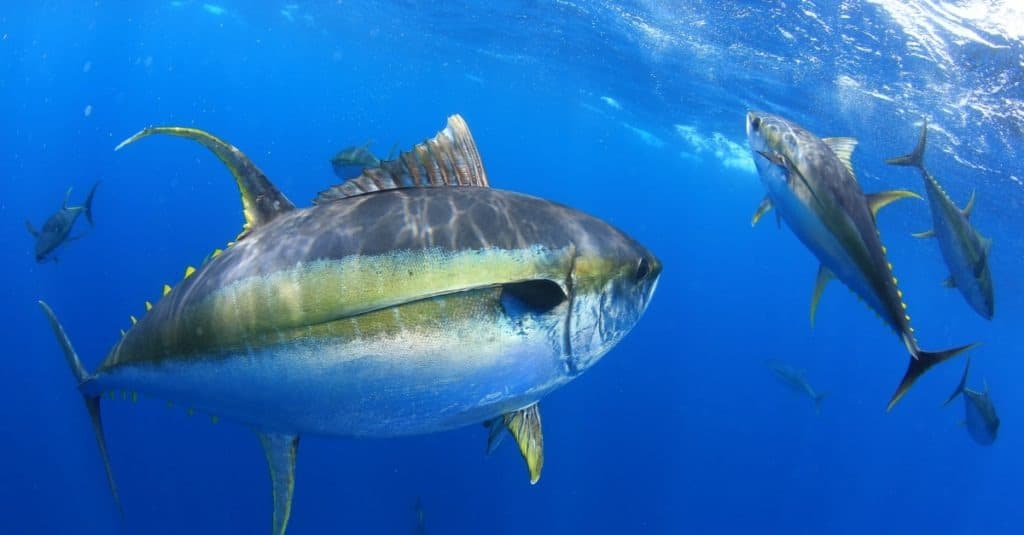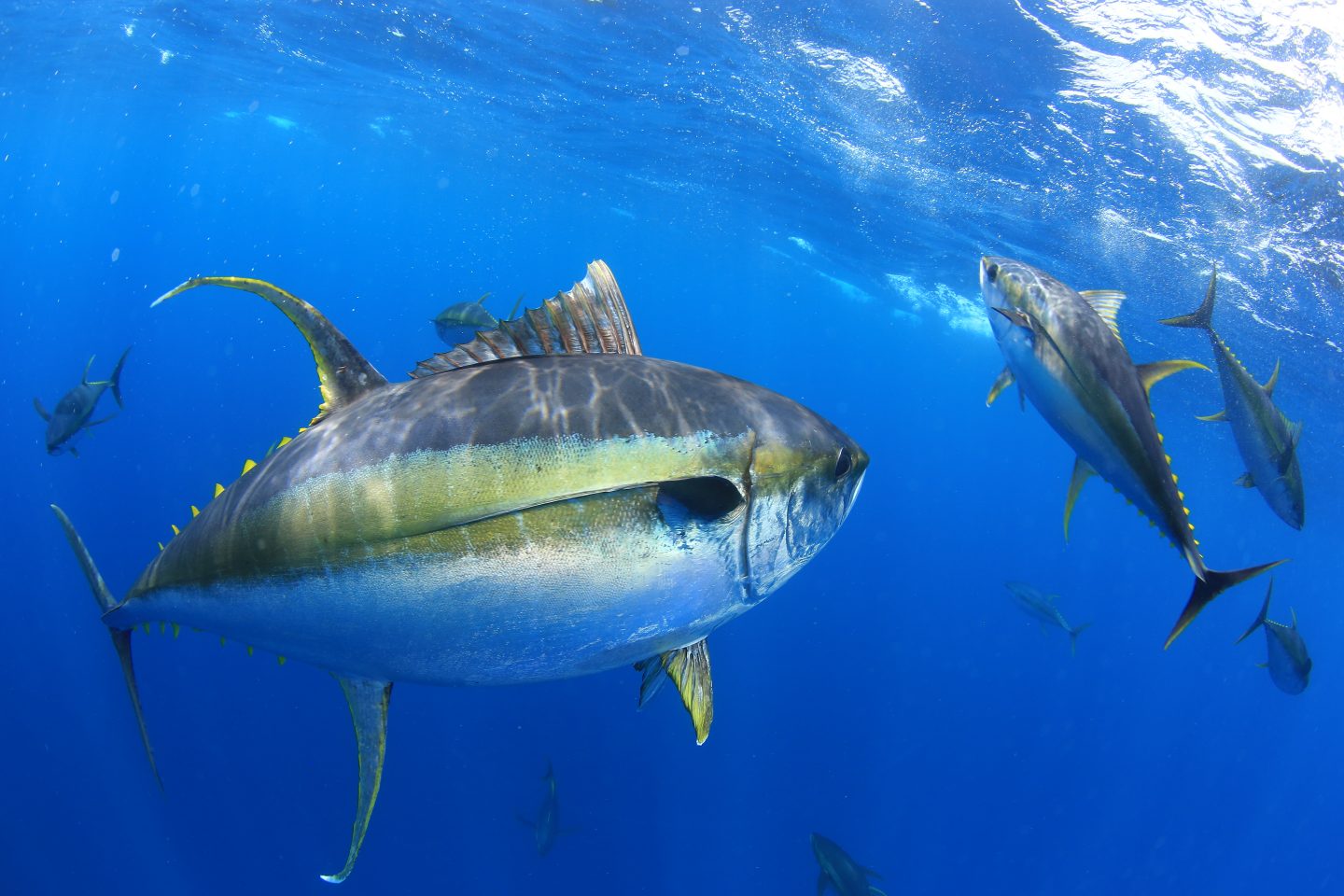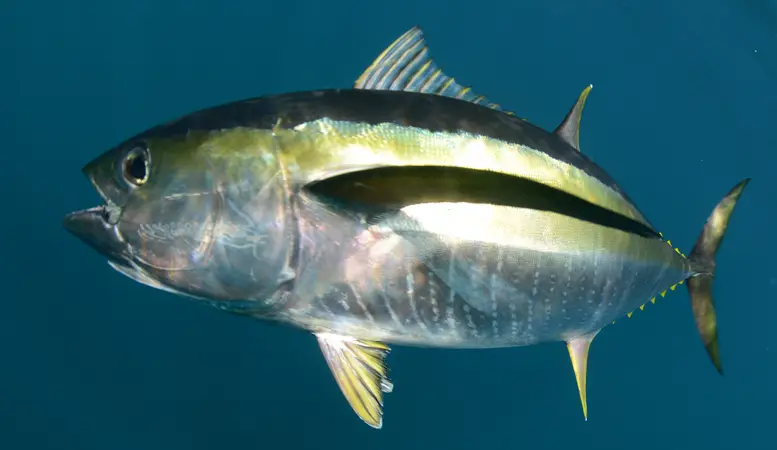Yellowfin Tuna Overview

Yellowfin tuna, scientifically known as Thunnus albacares, is a popular species of tuna found in pelagic waters around the world. Known for its vibrant yellow finlets and sleek body shape, yellowfin tuna is highly prized for its culinary uses. It is known to grow up to 80 pounds and reach lengths of up to 30 inches. This species exhibits a firm texture and a mild, slightly sweet flavor. Yellowfin tuna is versatile and can be cooked in various ways, making it a favorite among seafood lovers and chefs alike.
Yellowfin Tuna Appearance And Habitat
Yellowfin tuna, also known as Thunnus albacares, can be easily recognized by its vibrant yellow finlets and sleek body shape. It has a streamlined build and is known to grow up to 80 pounds in weight and reach lengths of up to 30 inches.
Yellowfin tuna are commonly found in pelagic waters around the world, including the Atlantic, Indian, and Pacific Oceans. They prefer warm waters and are often found near the surface, although they can also dive to considerable depths. They are highly migratory fish and are known to travel long distances in search of food and favorable conditions.
Yellowfin Tuna Culinary Uses And Nutritional Value
Yellowfin tuna is highly valued in the culinary world for its versatility and rich flavor. Its tender flesh and mild taste make it suitable for a variety of dishes, including sushi, sashimi, grilling, and searing. The meat’s firm texture holds up well to cooking methods that require higher heat. From fresh tuna bowls to spicy tuna rolls, yellowfin tuna adds a vibrant and savory element to any recipe. In terms of nutritional value, yellowfin tuna is packed with protein, omega-3 fatty acids, and essential vitamins and minerals, making it a healthy and nutritious choice for seafood lovers.
Yellowtail Tuna Overview

Yellowtail tuna, scientifically known as Seriola lalandi, is a popular and highly sought-after species in the world of seafood. It is found in both Atlantic and Pacific oceans. Yellowtail tuna is characterized by its sleek and streamlined body, with a distinct yellow strip running along its lateral line. It can grow up to 80 pounds in weight and reach lengths of up to 30 inches. This species is known for its firm and flavorful flesh, making it a favorite among sushi and sashimi enthusiasts. Its versatility in culinary applications and its abundance in the ocean make yellowtail tuna a prized catch for both professional and recreational fishermen.
Yellowtail Tuna Physical Characteristics And Distribution
Yellowtail Tuna, also known as Seriola lalandi, possesses distinct physical characteristics and has a wide distribution. These tuna have a sleek and streamlined body, adorned with a vibrant yellow stripe along their lateral line. They can grow up to 80 pounds in weight and reach lengths of up to 30 inches. Yellowtail Tuna are found in both Atlantic and Pacific oceans, inhabiting coastal waters and offshore regions. Their distribution spans from southern California to Chile in the Eastern Pacific, and from South Africa to Australia in the Indian Ocean. They are highly prized for their firm and flavorful flesh, making them a popular choice among seafood enthusiasts.
Yellowtail Tuna Flavor Profile And Culinary Applications
Yellowtail Tuna has a distinct flavor profile that is often described as mild, slightly sweet, and buttery. The flesh of Yellowtail Tuna is firm yet tender, with a delicate texture that melts in your mouth. This makes it a popular choice for sushi and sashimi preparations. Its mild flavor also makes it versatile in various culinary applications. Yellowtail Tuna can be enjoyed raw, grilled, roasted, or even smoked. It pairs well with citrus-based marinades, soy-based sauces, and aromatic herbs and spices. Its versatility makes it a favorite among chefs and seafood enthusiasts alike.
Yellowfin Tuna Fishing And Sustainability

Yellowfin tuna fishing practices have raised concerns regarding their sustainability due to their high demand and vulnerability to overfishing. Yellowfin tuna is commonly caught using purse seine nets, longlines, and pole-and-line methods. However, these fishing techniques can result in bycatch of other species, including endangered marine animals such as sea turtles and sharks. To address these concerns, various organizations and regulations have been established to promote sustainable fishing practices, such as setting catch limits, implementing size restrictions, and enforcing fishing gear modifications to reduce bycatch. It is crucial for fishermen and consumers to support sustainable fishing efforts to ensure the long-term survival of yellowfin tuna populations.
Yellowfin Tuna Fishing Methods And Sustainability Practices
Yellowfin tuna is commonly caught using purse seine nets, longlines, and pole-and-line methods. These fishing techniques can result in bycatch of other species, including endangered marine animals such as sea turtles and sharks. To address sustainability concerns, regulations and organizations have been established to promote sustainable fishing practices. This includes setting catch limits, implementing size restrictions, and enforcing fishing gear modifications to reduce bycatch. It is essential for fishermen and consumers to support these sustainable fishing efforts to ensure the long-term survival of yellowfin tuna populations.
Yellowfin Tuna Conservation Efforts And Regulations
Yellowfin tuna conservation efforts and regulations are in place to ensure the sustainable management of this valuable species. International organizations such as the International Commission for the Conservation of Atlantic Tunas (ICCAT) and the Western and Central Pacific Fisheries Commission (WCPFC) have implemented measures to control and monitor yellowfin tuna fishing activities. These include setting catch limits, implementing size restrictions, and enforcing fishing gear modifications to reduce bycatch. Additionally, consumer awareness and support for sustainably harvested yellowfin tuna can contribute to the preservation of its populations for future generations.
Yellowtail Tuna Fishing And Sustainability

Yellowtail tuna fishing practices have raised concerns about their impact on the environment and the species’ sustainability. Commercial fishing methods commonly used for yellowtail tuna, such as longline fishing and purse seining, can result in high levels of bycatch, including non-targeted fish species and sea turtles. These methods can also damage sensitive marine habitats. To address these issues, sustainable fishing practices for yellowtail tuna have been developed, including the use of selective fishing gear and techniques that minimize bycatch and protect the marine ecosystem. Implementing these sustainable fishing practices is crucial for the long-term viability of yellowtail tuna populations.
Yellowtail Tuna Catching Techniques And Environmental Impact
Yellowtail tuna is typically caught using various fishing techniques, including longlining, trolling, and purse seining. Longlining involves setting a long line with multiple baited hooks to catch the tuna. Trolling uses lures or bait to attract the fish while the boat moves at a slow speed. Purse seining involves deploying a large net to encircle and capture the tuna. However, these fishing methods can result in significant environmental impacts. They can lead to high levels of bycatch, including non-targeted fish species and endangered marine animals like sea turtles. Additionally, these practices can damage fragile marine habitats, such as coral reefs. Therefore, it is crucial to adopt sustainable fishing practices, such as using selective gear and implementing fishing guidelines, to reduce the environmental impact of yellowtail tuna fishing and ensure the long-term sustainability of the species and marine ecosystems.
Yellowtail Tuna Conservation Initiatives And Management
Yellowtail tuna conservation initiatives have been implemented to ensure the sustainable management of this species. These initiatives include the establishment of marine protected areas and the implementation of fishing regulations and restrictions. For example, size and catch limits are set to prevent overfishing and protect the reproductive capacity of yellowtail tuna populations. Additionally, efforts are being made to promote responsible fishing practices and educate fishermen about the importance of conservation. Collaboration between government agencies, conservation organizations, and the fishing industry is vital for effective management and conservation of yellowtail tuna populations.
Yellowfin Vs Yellowtail Tuna: Taste And Texture

When it comes to taste and texture, yellowfin and yellowtail tuna have distinct differences. Yellowfin tuna has a moderate flavor and a firmer texture, whether it is wild-caught or farmed. On the other hand, yellowtail tuna, especially the farmed variety, offers a richer and buttery mouthfeel. Additionally, yellowfin tuna is known for its vibrant red color, which adds visual appeal to any dish. Ultimately, the choice between yellowfin and yellowtail tuna comes down to personal preference and the desired taste and texture for a particular recipe or meal.
Yellowfin Tuna Flavor And Texture Comparison
Yellowfin tuna is known for its moderate flavor and firm texture, whether it is wild-caught or farmed. Its flavor is often described as mild, slightly sweet, and with a hint of nuttiness. The firm texture of yellowfin makes it ideal for grilling or searing, as it holds its shape well. The meat has a meaty and slightly fibrous texture, which adds to its overall appeal. This combination of flavor and texture makes yellowfin tuna a versatile choice for a variety of culinary applications.
Yellowtail Tuna Taste And Texture Contrast
Yellowtail tuna offers a distinct flavor and texture compared to yellowfin tuna. Yellowtail has a milder and slightly sweet taste with a buttery mouthfeel, especially when it is farmed. Its texture is more tender and delicate, making it ideal for dishes that require a silky and melt-in-your-mouth experience. Compared to the firmer texture of yellowfin, yellowtail is more succulent and has a smoother mouthfeel. This contrast in flavor and texture makes yellowtail tuna a popular choice for sashimi and sushi preparations, where its delicate nature can shine.
Conclusion And Recommendations

In conclusion, yellowfin and yellowtail tuna are two distinct varieties that offer different characteristics and flavor profiles. Yellowfin tuna is known for its larger size and firmer texture, making it suitable for a variety of culinary preparations. On the other hand, yellowtail tuna has a milder and slightly sweet taste, with a tender and buttery texture that lends itself well to sashimi and sushi dishes.
When it comes to choosing between yellowfin and yellowtail tuna, it ultimately depends on personal preference and the specific recipe or dish being prepared. Both varieties provide delicious options for seafood lovers. For a richer and buttery experience, opt for yellowtail tuna, while those who prefer a firmer texture can choose yellowfin tuna.
Distinguishing Yellowfin And Yellowtail Tuna
Yellowfin and yellowtail tuna can be distinguished based on various factors. Yellowfin tuna is larger in size, reaching weights of up to 80 pounds and lengths of up to 30 inches. It has a firmer texture and a red color that makes it visually appealing. On the other hand, yellowtail tuna is smaller, with a maximum weight of around 36 kg. It has a milder flavor and a tender, buttery texture. The distinct characteristics of each tuna variety make them suited for different culinary preparations.
Recipes And Cooking Tips For Yellowfin And Yellowtail Tuna
Yellowfin and yellowtail tuna can be prepared in various delicious ways. For yellowfin tuna, try seared yellowfin tuna with wasabi and soy sauce for a flavorful and Asian-inspired dish. Another popular recipe is grilled yellowfin tuna with avocado salsa, where the creamy avocado complements the firm texture of the tuna. As for yellowtail tuna, grilling is a great option. Prepare grilled yellowtail with herb butter for a flavorful and aromatic meal. You can also try roasted yellowtail with lemon and garlic for a simple and flavorful dish. These recipes showcase the unique flavors and textures of each tuna variety.
FAQ About Yellowfin Vs Yellowtail Tuna: Contrasting Tuna Varieties
Q: What is the main difference between Yellowfin and Yellowtail Tuna?
A: The main difference lies in their taste and texture. Yellowfin Tuna is leaner with a mild flavor, while Yellowtail Tuna is fattier and has a richer flavor.
Q: How do the sizes of Yellowfin and Yellowtail Tuna compare?
A: Yellowfin Tuna generally grows larger, reaching around 400 pounds, whereas Yellowtail Tuna typically weighs between 10 to 50 pounds.
Q: Which tuna variety is better for sashimi or sushi?
A: Yellowtail Tuna is preferred for sashimi and sushi due to its buttery texture and rich taste, whereas Yellowfin Tuna can also be used but is more commonly cooked.
Q: Are there any differences in the color of the flesh of Yellowfin and Yellowtail Tuna?
A: Yes, Yellowfin Tuna has a lighter pink flesh, while Yellowtail Tuna has a deeper red color.
Q: Where are Yellowfin and Yellowtail Tuna commonly found?
A: Yellowfin Tuna is distributed worldwide in tropical and subtropical waters, while Yellowtail Tuna is commonly found in the Pacific Ocean, particularly off the coast of California and Mexico.
Q: Which tuna variety is more commonly used in canning?
A: Yellowfin Tuna is more commonly used for canning due to its larger size and firm texture, making it ideal for preserving.

Marine Bay Restaurant received the International Food Culture Award 2019 as the Best Szechuan & Hunan Restaurant, enjoying a reputation in North America. Renowned for the tunnel, authentic, and cheap. Known as “Human Taste First Garden,” 2013 Vancouver culinary first book named “Best Chuan Xiang Outlets,” significant temperature and China Eastern Airlines designated outlets.